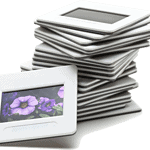Table of contents
How do I scan photos myself?
What resolution do I need when scanning pictures?
Which file format should I use when scanning pictures?
How can I edit images after scanning?
Should I have pictures digitised or scan them myself?
Where can I have pictures scanned?
How do I scan photos myself?

Clean your photos, slides and negatives before scanning them. Remove dust with a soft brush or canned air spray. Digitise the pictures, using a photo or slide scanner. If needed, edit the images afterwards with an image editing software.
Before you start scanning, sort out pictures you don’t want to convert, such as too dark or blurred ones.
What kind of scanner do I need to scan photos, slides and negatives?
To digitise slides and negatives you need a slide scanner. Most slide scanners can also process negatives. If you own slides as well as negatives, you should get a combination device that scans both. Don’t make the mistake to get the cheapest one available. We tested different slide scanners and the results show that the cheap ones unfortunately produced unsatisfying image quality. They often have a low basic resolution and then interpolate the scans to advertise higher resolutions.
Scanning pictures yourself: The costs
To clean your pictures properly you need a soft brush and compressed air spray. For handling slides and negatives, wear cotton gloves to avoid fingerprints. These things will add up to about £10.00 to 15.00.
For photo prints, use a flatbed scanner. Most document scanners can also process photo prints but the outcome won’t be as good, as their focus lies elsewhere. That is why you should use a device specifically designed to digitise photos.
In order to avoid frustration you should invest in a high-quality slide scanner. Good scanners would be the Reflecta DigitDia 6000 for around £1,300.00 or the EPSON Perfection V850 for around £700.00. Both devices include a professional scanning software. They can remove dust and scratches from the scanned image by post-editing. Furthermore they score with natural colours, good sharpness, high optical resolution and storage as TIFF files. Therefore, high-quality scanners can ensure a good quality for post editing.
DigitDia600 exclusively scans slides but can process whole magazines automatically. If you plan on scanning slides, negatives and photos, the EPSON V850 would be the right choice – it can scan 35mm, medium- and large-formats.
To store the scanned picture, you still need a hard disk. The costs depend on the size of your collection, the file format and the chosen resolution. Usually a 500 GB hard disk is big enough to store all your images. You can get one for about £40.00.
Scanning pictures yourself: overview of costs
| Scanner | £700.00 – 1,300.00 |
| Cleaning materials | £10.00 – 15.00 |
| Hard disk | £40.00 |
| Total | £850.00 – 1,355.00 |
If you would rather save some money, you can also send MEDIAFIX a non-binding request for the digitisation of your images.
Scanning pictures is time consuming and requires patience
A high image quality requires a long scanning time. Since you intend to digitise your slides, negatives and prints only once, the quality should be excellent. Digitised images are meant to last for a long time and will make your children and even your grandchildren smile when you pass them on to them.
Our tests have shown that high-quality scans (whether for slides, photos or negatives) always take several minutes. For example, the DigitDia 6000 needs about 7 minutes per scan at 5,000 dpi, EPSON Perfection needs 4:20 minutes at 4,800 dpi.
Time consuming factors when scanning pictures yourself
- Sort through the pictures (usually not every picture is supposed to be scanned)
- Inserting and removing the pictures
- Setting up the scanner and software
- Actual scanning time
- Renaming the image files
- Image editing
If you own a big collection with hundreds of negatives or thousands of slides, the whole process can take weeks or even months. To save some time, you can let MEDIAFIX scan your pictures.
What resolution do I need when scanning pictures?
The resolution depends on the image material and the subsequent use of the scans. Slides and negatives should be scanned with at least 1,400 dpi. Photos with at least 300 dpi. The reason: a slide is much smaller than a standard photo print. This is why you need a higher resolution for slides and negatives than for photos in order to display them digitally in the same size.
Digitise pictures: An overview of resolutions
| Usage | Photos | 35mm slides | 35mm negatives |
| HD screen (PC/TV) | 300 dpi | min. 1,400 dpi | min. 1,400 dpi |
| Print up to A4 | 600 dpi | min. 1,750 dpi | min. 1,500 dpi |
| Print A3+ | 600 dpi | min. 2,500 dpi | min. 2,000 dpi |
| Fine Art Print | 600 dpi | min. 3,000 dpi | min. 3,000 dpi |
| Archiving | 600 dpi | Maximum optical resolution | Maximum optical resolution |
Which file format should I use when scanning my pictures?
The most common file format for images is JPG or JPEG. All scanners offer this format. If you want to professionally edit your pictures, you should store your digitised images as TIFF file. This format contains a lot more image information, but at the same time needs more storage space. Attention: Before buying a scanner, make sure it can generate TIFF files.
How can I edit images after scanning?
Some pictures need editing after scanning them. For rudimentary tasks such as cropping images, you can just use Paint. If you want to edit your images more professionally you can download an editing software. The most common software available for purchase is Photoshop. It includes countless features but can be quite complicated to use for beginners. Free editing software like Gimp include a lot of features as well. Somewhat easier to use but also more limited in its possibilities is the freeware Photoscape.
Should I have pictures digitised or scan them myself?
This is a decision only you can make. Scanning pictures is time consuming and expensive. On the plus side you don’t have to hand your pictures to someone else. If you let a service provider scan your pictures, there is no need to think about all the different technical aspects. That way you can save a lot of precious free time. At MEDIAFIX you submit a non-binding request and send us your media along with a signed order form. We take care of the rest. Once your order has been processed, we will return it to you by mail.
| Scan yourself | Scanned at MEDIAFIX | |
| Time investment | high | low |
| Cost | high | from 17p / slide |
| Effort | high | low |
| Technical know-how | ? | high |
Where can I have my pictures scanned?
 You can have your photos, slides and negatives scanned at MEDIAFIX. Thanks to our self-developed scanning technology, we digitise photos, negatives and slides in high resolution and within the shortest time possible. We pass these time savings on to our customers. You will receive our best-price-guarantee.
You can have your photos, slides and negatives scanned at MEDIAFIX. Thanks to our self-developed scanning technology, we digitise photos, negatives and slides in high resolution and within the shortest time possible. We pass these time savings on to our customers. You will receive our best-price-guarantee.
 Scan slides from 17p / slide up to 6,200 dpi
Scan slides from 17p / slide up to 6,200 dpi
Scan negatives from 17p / negative up to 6,200 dpi
Scan photos from 17p / photo up to 1,200 dpi
Over 209 million digitised memories and more than 1,500 positive reviews on Google speak for our service. Tens of thousands of satisfied customers speak a clear language. Join them and have your pictures scanned.
Do you have any questions? Our friendly customer service will be happy to advise you personally!
Call us 020 3904438-0
Our phone hours are:
Mon-Fri 10.00 a.m. - 3.00 p.m.



 Don’t hesitate any longer, have your analogue slides, photos and negatives digitised now, before it’s too late. You can currently benefit from our special offer.
Don’t hesitate any longer, have your analogue slides, photos and negatives digitised now, before it’s too late. You can currently benefit from our special offer.